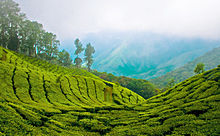Field trip
he name Munnar is believed to mean "three rivers",[4] referring to its location at the confluence of the Mudhirapuzha, Nallathanni and Kundali rivers.[5]
History
The region has been inhabited by hunter-gatherer tribals like the Malayarayan and Muthuvan for thousands of years.[6] Tradition states that Colonel Arthur Wellesley, later the Duke of Wellington, was the first British person to pass through Munnar during Tippu Sultan's campaign in Travancore, but this is unsubstantiated. The first survey of the terrain was undertaken by Benjamin Swayne Ward in 1816–1817, who followed the Periyar into the Western Ghats and established a camp at the confluence of three rivers, from which the name of Munnar is derived.[7]
It was to be nearly 50 years later that Sir Charles Trevelyan, Governor of Madras, instructed Col. Douglas Hamilton to explore the hill country in the western part of the Madras Presidency, requesting special advice on the feasibility of establishing sanatoria for the British in the South and of developing revenue- earning projects without endangering the environment, as had happened in Ceylon where coffee had destroyed not only the rain forest but also paddy cultivation in the north-central rice bowl of ancient Ceylon. Hamilton climbed throughout the Ghats in Munnar region. 15 years later, John Daniel Munro noted that much of Munnar's land was suitable for coffee plantations. Munro, Henry Turn and his half-brother AW Turner obtained ownership of the Cardamom Hills from the Raja of Travancore and began clearing forest around Devikulam in 1879. Soon many other Europeans began establishing tea plantations in the area throughout the 1880s. Early plantations had few facilities and were mainly huts of straw. Most labourers on the tea estates were Dalits from present-day Tamil Nadu.[8][6]
Eventually roads were opened to the lowlands and in Bodinayakanur in western Madras Presidency, planters got provisions from a local headman - Suppan Chetty. He and his son, Alaganan Chetty (later an MLA) would continue providing supplies to the tea estates in the region. By 1894, 26 estates were established in the hills but all were facing losses. In 1897, a separate company, Kannan Devan Hills Corporation (KDHC) was registered to operate the tea estates which was later taken over by the American Direct Tea Trading Company Ltd., who owned 26 estates, most with coffee and some with cinchona, almost all in the area except for a few in the lower areas.
In 1900, a ropeway was built and eventually monorails were installed for easier transport of goods to the plains. In 1901, P. R. Buchanan took over as General Manager and began the most extensive clearing of jungles for plantations. In 1908, construction started on a new railway which opened in 1909. By 1911, around 16,000 acres of the region was under cultivation.
In 1924, a flood swept through Munnar, damaged the road and destroyed the rail track. In its place it was decided to create a ropeway to transport tea. In 1930, this in turn was replaced by a modern road that made transport much easier. By 1952, almost 28,000 acres of land was under cultivation. After Independence, Indian planters took over. In 1964, the KDHC which owned most tea estates was acquired by Tata and Finlay who started the first instant tea factory in the country. In 1971, the Kerala government wanted to reforest all land in the hills not used for plantations. However negotiations that followed resulted in Tata keeping most of the land, leaving it with 57,000 acres.









Comments
Post a Comment